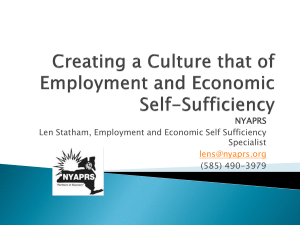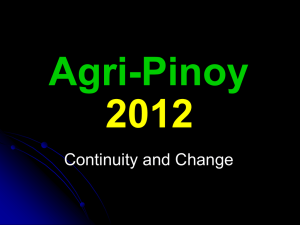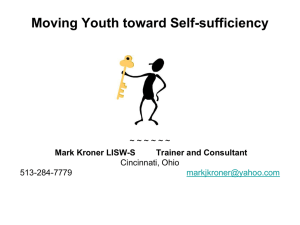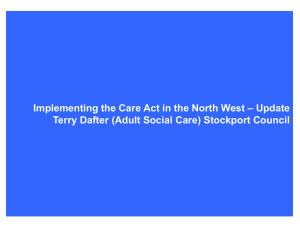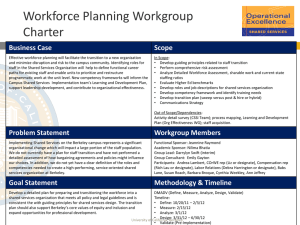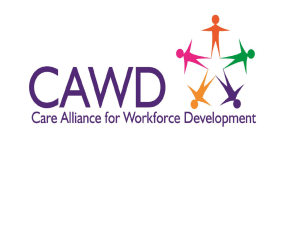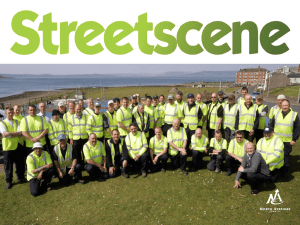Self-Sufficiency Continuum
advertisement
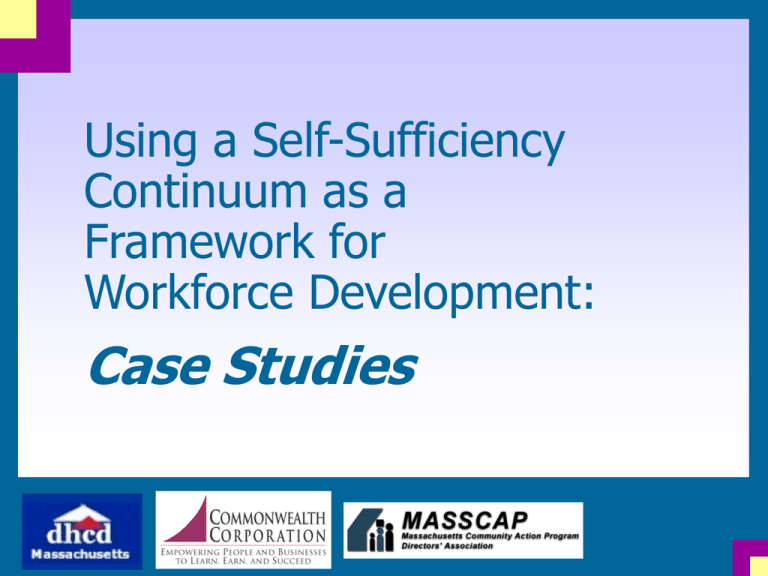
Using a Self-Sufficiency Continuum as a Framework for Workforce Development: Case Studies Overview What is a self-sufficiency continuum? What are the various dimensions of self-sufficiency? How is a self-sufficiency continuum relevant to workforce development? Is anyone using this framework? Why isn’t everyone using it? Am I already using aspects of it? How can I use it? What resources are available? 1 A Research Project on This Topic The project team: Massachusetts Department of Housing and Community Development Commonwealth Corporation & FutureWorks Massachusetts Community Action Program Directors’ Association (MASSCAP) Several community/faith-based organizations 2 Workforce Development: An Evolving Approach You’re probably familiar with various workforce development concepts, and many of you already have considerable experience building self-sufficiency in your communities. So, the information in this session might not be breaking news. But it’s worth your consideration nonetheless, because the approach to workforce development continues to evolve. 3 The Problem and the Challenge Problem: Many people remain in poverty despite full-time employment. This suggests that finding a job is not always the end of the story. Challenge: Community/faith-based organizations are encouraged to consider approaches that will address the need of individuals and families for a continuum of support in achieving self-sufficiency. 4 A Holistic Approach to Workforce Development Our preliminary research found: Some community-based organizations are attempting to implement their workforce development programs within a larger framework—the self-sufficiency continuum. These efforts are interesting for what they can tell us about possible models to follow and what issues to anticipate. 5 Definition of “Self-Sufficiency Continuum” A framework within which an organization provides access to a succession of education, training, and employment-related services—along with an array of wrap-around support services—through the duration of an individual’s or a family’s journey from poverty to economic self-sufficiency. Our project focused primarily on economic self-sufficiency. Two points about this focus: Economic self-sufficiency in this context goes beyond meeting federal poverty guidelines. We recognize that there are also social, cultural, and civic dimensions to self-sufficiency. However, the time and resources available for this project did not enable us to research these other relevant aspects. 6 Research Review and Discussion We’re going to quickly summarize findings from interviews with some pioneering organizations in this area. And then, we’ll talk about whether a similar approach—or some aspect of it—makes sense for your organization. Even if it’s only as a longer term objective. For those of you already thinking about this type of approach to workforce development: You might get some ideas or gain insight to pitfalls that have been encountered. At the least, this session is intended to get you thinking about the possibilities—or feasibility—of taking a big-picture approach to workforce development. 7 Concept vs. Implementation Implementing workforce development within the context of a self-sufficiency continuum is not easy. There are some significant barriers— including the current public policy climate. As a result, only a handful of organizations appear to be using it. But, a good case can be made for the wisdom of this approach…and the need. And there’s information and some useful tools for getting started. 8 A Collaborative Research Effort The research project involved conducting a review of approaches to workforce development at community/faith-based organizations. This review led to the development of case studies and other materials. The project team members and roles are: Massachusetts DHCD: Overall project management and support. Commonwealth Corporation: Management of research effort. MASSCAP: Information dissemination support. Case studies developed by FutureWorks, a consulting and policy development firm. Project partners include representative community/faith-based and other organizations. 9 The Project Partnership Mass Workforce Alliance Massachusetts Association of Community Development Corporations Workforce Investment Boards DHCD FutureWorks Self-Sufficiency Continuum Center for Law and Social Policy National Center for the Study of Adult Learning and Literacy Hispanic-American Chamber of Commerce Workforce Development COMMCORP Community Development Corporations Faith-Based Groups MASSCAP Community Economic Development Assistance Corporation Community Action Agencies 10 Output from the Project A case study report: Do You Know the Way to Self-Sufficiency? A Case Study Report on Using a Self-Sufficiency Continuum Framework to Guide Workforce Development Programs and Policies Profiles of organizations interviewed for this study. Research and evaluation brief about the project. Self-sufficiency continuum framework mapping workbook. 11 Project’s Objective and Key Finding The key objective was to identify best practices from a selection of community-based organizations that have implemented this approach to workforce development. Key Finding: Our literature search identified very few organizations using a self-sufficiency continuum framework to guide their programming and service mix. For most organizations, delivery of services stopped after an individual found an entry-level job. The report’s case studies focus on the few organizations identified that attempt to provide access to support services all the way to self-sufficiency. 12 Key Finding in Context: Barriers This key finding is not particularly surprising, given the significant barriers/challenges to using this approach to workforce development: The current public policy emphasis on a “work first” approach for workforce development and welfare programs inhibits the use of most public funding to provide long-term support for achieving self-sufficiency. The current economy is not generating many new jobs, particularly the types of jobs that provide opportunities for achieving economic self-sufficiency. 13 Key Finding in Context: Potential Drivers Despite these barriers, some of the research results were encouraging: A continuum framework appears to present a useful mechanism for tracking an organization’s response to an individual’s immediate needs within the context of longer term objectives. Strategic partnerships and coordination with other organizations (both public and private) make it possible to establish a continuum that provides the necessary mix of services. Some tools exist and some initiatives are under way that support establishing a continuum framework (e.g., some of you may be familiar with Scales and Ladders matrices, Self-Sufficiency Standards, ROMA performance measurement guidance materials). 14 The Case Studies The research report presents four case studies about: A “one-stop shop” that draws on long-term experience. A partnership approach. Another partnership approach. An approach with a particular emphasis on performance measurement. 15 The Continuum Framework: Mapping Progress CAAs, CDCs, CBOs, human service providers Outreach/recruitment Intake/assessment/ screening Assistance with accessing support services Refugees/immigrants: immigration and torture counseling CAAs, CDCs, CBOs, employers, one-stop centers ESL, VESL, ABE/GED, pre-vocational/ employment skills training Life skills training/ personal success plan development Job development/ placement Early career planning Immigration/naturalization counseling Entrepreneurial training CAAs, CDCs, CBOs, employers, bridging to post-secondary education, financial institutions Job retention and advancement supports, i.e., mentoring, peer support groups, employer contact, skill upgrading, career ladder movement, career planning Financial literacy and support services, i.e., EITC, IDAs, home ownership counseling CAAs, CDCs, CBOs, employers, post-secondary education, financial institutions CAAs, CDCs, CBOs, employers, post-secondary education, financial institutions Support on an "as needed" basis only Opportunities to "give back" to community, i.e., alumni events, graduate to mentor Career advancement supports, i.e., support for licensure, credentialing, and degrees; employerfunded training/OJT; mentoring; peer support groups Advanced financial literacy and supports Thriving Stable Safe At-Risk In-Crisis No income or assets No skills or credentials Homeless or unstable housing No or unreliable transportation No or unreliable child care Safety and mental health risks are high Seeking job or temp/seasonal job or other legal income Seeking GED or vocational training Seeking ESL Temporary or transitional housing Transportation and child care available, but not affordable or reliable Employed in semi-stable job Has high school diploma, GED, or vocational training Housing is not temporary and is affordable (maybe with subsidy) Transportation and child care are generally reliable and affordable Permanent & stable job Career & educational plan in place; active & on-going learning Housing is not temporary & is affordable (maybe with subsidy) Transportation and child care are reliable and affordable Permanent, stable employment of choice Implementing education and career plan Housing is not temporary & is affordable without subsidy Transportation and child care are reliable and affordable 16 A One-Stop Shop on the Path to Self-Sufficiency: Case Study #1 Asian Neighborhood Design—Program Overview Non-profit community development agency with 6 years of experience using a self-sufficiency framework. Training program in the building trades (e.g., carpentry, cabinetmaking). 100 to 150 trainees graduate each year from 13-week training session. Furniture made by trainees sold commercially in non-profit enterprise. 17 A One-Stop Shop on the Path to Self-Sufficiency: Case Study #1 Asian Neighborhood Design—Program Approach “Essential Elements” for tracking trainees’ and graduates’ path to self-sufficiency. Trainees meet each week with a family advocate to establish a baseline situation, identify barriers/assets, and develop a plan. Graduates are assisted with job placement and encouraged to join the Jobs Plus Club, where they meet with peers and make a 2 to 4 year commitment to work toward self-sufficiency through “asset-building opportunities.” 18 A One-Stop Shop on the Path to Self-Sufficiency: Case Study #1 Asian Neighborhood Design— Tracking Self-Sufficiency The 7 Essential Elements of a Healthy Community provide a framework for tracking individual’s progress in regard to assets and barriers: Income/Assets Education/Skills Housing/Food Safety/Environment Human Services Relationships Personal Attributes 19 A One-Stop Shop on the Path to Self-Sufficiency: Case Study #1 Asian Neighborhood Design—Key Practices Big picture approach: building up an individual’s “assets” promotes self-sufficiency for families and ultimately empowers the community. Advocates act as “brokers” of comprehensive support services on path to self-sufficiency. Program partnerships exist with 70 other agencies through Memorandums of Understanding. Each individual’s progress is tracked and each plan for achieving self-sufficiency is revisited. 20 A One-Stop Shop on the Path to Self-Sufficiency: Case Study #1 Asian Neighborhood Design— Barriers Encountered Mission considerations: community revitalization vs. human service delivery. Limited funding for providing long-term support. Target population is highly mobile. 21 Partnerships to Promote Self-Sufficiency: Case Study #2 ABCD-NECF Partnership—Program Overview Action for Boston Community Development (ABCD) is a private, non-profit human services agency. The New England College of Finance (NECF) is a not-for-profit educational organization focused on the financial services industry. As key partners: ABCD refers and supports individuals training for entry-level financial services jobs & NECF hosts the “Financial Services Academy” for training and continuing education. Local financial institutions fund and develop the curriculum. 22 Partnerships to Promote Self-Sufficiency: Case Study #2 ABCD-NECF Partnership—Program Overview (continued) The employment opportunity that gave rise to this initiative: Traditional practice of hiring college graduates resulted in high turnover. High cost to industry for training and for recruitment through employment agencies. Industry needs to meet Community Reinvestment Act requirements. ABCD and other organizations seeking jobs with career potential for workforce development programs. After 5 years: 400 graduates and 85% placement. 23 Partnerships to Promote Self-Sufficiency: Case Study #2 ABCD-NECF Partnership—Program Approach 3-week intensive training program: Monday to Friday, 9 to 5. Curriculum includes classroom learning, role playing, visits to financial institutions. As-needed support services provided throughout the training. Graduates are assisted with job placement and have access to continuing education. 24 Partnerships to Promote Self-Sufficiency: Case Study #2 ABCD-NECF Partnership—Key Practices The right match: interested prospective employees & good business for employers. High-profile industry representative championed the program to financial institutions. The industry’s investment in the program supports its commitment to success and sustainability. 25 Partnerships to Promote SelfSufficiency: Case Study #2 ABCD-NECF Partnership— Future Challenges Concern about ongoing support should industry champion leave. Program is focused exclusively on financial service, thus need to expand the model to address other skill sets and interests. 26 Partnerships to Promote Self-Sufficiency: Case Study #3 JPNDC and Partners—Program Overview Jamaica Plain Neighborhood Development Corporation is a non-profit community development agency in a diverse neighborhood of Boston; JPNDC is relatively new to workforce development. Through welfare-to-work initiatives, JPNDC had developed strong connections with local health care institutions. Teamed with another CDC to develop training program and secure funding from the state and Fleet Bank. Established the “Boston Health Care Research Training Institute” for providing training to individuals in entrylevel positions in the health care field. 27 Partnerships to Promote Self-Sufficiency: Case Study #3 JPNDC and Partners—Program Approach Help advance entry-level health care employees to positions with family-sustaining wages. Program candidates must have been with a current employer for 6 months. Training is conducted at a central facility located in the Longwood Medical area. JPNDC provides mentoring, referral for support services, and career planning/counseling services. 28 Partnerships to Promote Self-Sufficiency: Case Study #3 JPNDC and Partners—Key Practices Early driver was acute labor shortages in health care industry and prominence of this industry in the Boston area. Employer/industry champion important for recruiting employer partners. Training delivered at a convenient time and location. Ability to secure funding: combining public and private sources. 29 Blazing the Path: Case Study #4 Jewish Vocational Service of Greater Boston— JVS Perspective Non-profit, non-sectarian agency providing workforce development services for over 60 years. In 2000, JVS decided to reconsider the way it “does business” in response to the “work first” public policy shift and other funding-related changes. Awareness of employers’ increasing need for skilled and trained workers. Current environment not promoting self-sufficiency. 30 Blazing the Path: Case Study #4 Jewish Vocational Service— Recalibrated Mission After an 18-month strategic planning process, JVS decided to be more “client focused” than “program focused.” Two key priorities were identified: A commitment to lifelong work-related planning and learning. A dedication to improving job opportunities through services to employers. 31 Blazing the Path: Case Study #4 Jewish Vocational Service—Program Approach Resulting workforce development program— Center for Careers and Lifelong Learning (CALL): Participants work with staff to establish baseline assessment. Develop long-term goals and short-term objectives. Continuous support from pre-employment to placement and beyond, with referrals for “wrap-around” support services. 32 Blazing the Path: Case Study #4 Jewish Vocational Service—Key Practices Comprehensive performance measurement approach with outcome goals and measures that are independent of individual funding requirements. Performance system framed by six over-arching strategic goals, such as “ensure clients develop work and life skills needed to obtain and maintain employment and family-sustaining wages.” IT system for internal tracking and for reporting performance results information. 33 Blazing the Path: Case Study #4 Jewish Vocational Service—Barrier Surmounted? JVS raised all of the $1.8 million in flexible funding needed to create the CALL program from foundations and private donors. It hopes to continue funding the program through similar flexible sources. 34 Blazing the Path: Case Study #4 Jewish Vocational Service—A True Pioneer JVS’s new organizational structure achieves something remarkable in support of a self-sufficiency continuum: Consolidates program services across funding streams. Allows staff to focus on “client” needs rather than exclusively on program requirements. Enables the organization to address individuals’ long-term needs on the path to self-sufficiency. 35 The Self-Sufficiency Continuum: Final Points “Wrap-around” support services tend to be essential for people striving to move beyond poverty—right up to achieving self-sufficiency. Community/faith-based organizations are still building up the capacity to implement this continuum concept as a central organizing principle. Strategic partnerships with other public and private organizations are often key to providing long-term service supports. Career ladder initiatives are promising workforce development models from which to establish a comprehensive continuum framework. 36 The Self-Sufficiency Continuum: Resources Case study report and program profiles. Framework mapping workbook. Other tools. Local and national organizations working in workforce development. 37 The Self-Sufficiency Continuum: Questions & Discussion Based on this current research information and your own experience, let’s consider whether aspects of the framework might make sense for your organization or those you work with. About the Overall Concept Does this general approach make sense? Is there a need to provide ongoing services after a “client” has found work? Is the notion of self-sufficiency specific enough as a long-term objective? 38 The Self-Sufficiency Continuum: Questions & Discussion Your Experience Is anyone here using this type of approach or something similar to it? If so, what results are you getting? 39 The Self-Sufficiency Continuum: Questions & Discussion Possibilities What aspects of this approach are possible/feasible? What needs in your community might provide a basis for using this approach? What are the barriers/challenges you would anticipate? Are there partnering possibilities? Are there funding possibilities? 40 The Self-Sufficiency Continuum: Questions & Discussion Tracking Performance How might you map “client” needs and program services on the continuum framework? Have you used a long-term assessment and tracking framework? If so, has it been useful? 41 Using a Self-Sufficiency Continuum as a Framework for Workforce Development Thanks for your interest and input. 42
